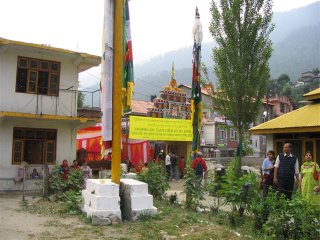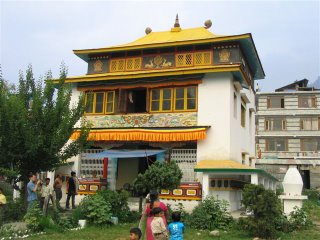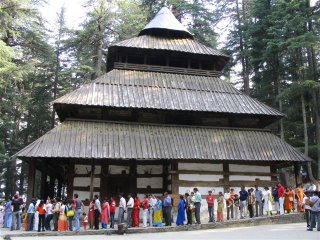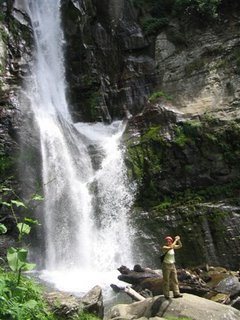Manali trip: Walk to Solang valley
The very beginning of the trek (Old Manali, right from Manulsu bridge) gives you a promising perspective on magnificent snow-covered peak, so seemingly close and so obviously remote.

By the steeps on the left you can study various rocks in their rich varieties and forms. On the right, across the river you get an overview of Vashish village. The trek is mostly flat and the sun is nicely warm, yet bright and we are not burdened with two-day provision as initially planed – what else to wish?
The first village comes soon and we climb down carefully stocked and covered with metal nets piles of stones and get right to a backyard of some house. The houses are built very close to each other and there is hardly any fences separating one from another. Mostly houses are two-storey and made of stone with wooden terrace encircling the building on the level of on the second floor.

It is very quiet around and you hardly notice any people outside. Whatever you see in the village is in the state of outstanding order and cleanness: being it a sleek cow, carefully stocked brushwood or contentiously groomed paths.

And the bushes of roses here and there just reinforce the feeling of the ultimate neat arrangement.

You get a feeling that things get done by invisible forces in this village. Unless you get quiet and watch. Then you notice women looking through wheat (picture by Roel)

Women weaving (picture by Roel)
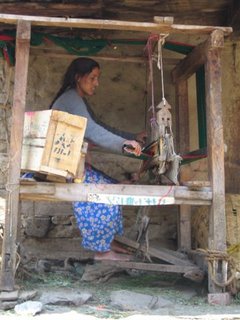
Old women sitting and talking

It takes just a couple of minutes to cross the village and we find ourselves in a small wheat field, the smallest one ever seen by me, a Russian used to the views of endless fields of collective farms.
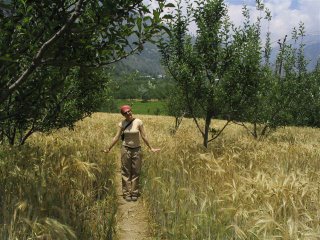
Further one we come across some women washing clothes in a stream (picture by Roel)

And a woman pasturing goats shows us a path through a swampy piece of land. Before we reach Shanag, the next village, we cross through numerous, but very small fields: potatoes, wheat, peas, again peas, potatoes wheat and peas again. The scarce land in the hills is carefully used for the essential food of the region – aloo, chapatti and dalh. There are many women working on the peas’ fields and while we stop for pictures they throw a couple of bean-pods for us with a laugh. That’s been a long time I haven’t had fresh green peas. After all, right before Shanag starts we come across a field with cannabis. Obviously, someone have to provide those down the hill in Manali. Believe or not, it was me pointing it out for Roel, assumingly a Dutch guy. We in Russia see in growing randomly as a weed on the streets, yet Dutch people are more familiar with its dry form.

In Shanag the major insight about the division of labor comes. After having seen armies of women working on the fields and weaving, the questions was hanging in the air. What about the men? Here we go: the men are found sitting altogether in some joint and peacefully talking. Very typical of a North-Indian village.
Shanag follows by a small bridge across the river and a very dramatic view over the mountains.


Once reached Buruwa, the last village in the program, the realization comes that village is not village. Isolated Goshal with its wooded houses hardly resembles well-connected, building up with fancy jeeps parked nearby Buruwa.
For little longer we follow dirt road until we reach a motorway. From that point we start wondering about further directions and the distance to Solang valley. During the two subsequent hours the answer we have been getting from any randomly picked up local “4 kilometers”. And when after a while we spotted the sign
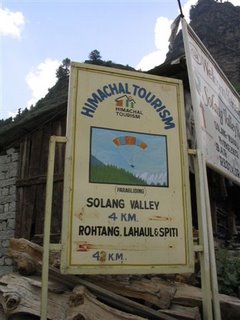
We have got the point then: you do not ask about distance in this country. Similarly, as “5 minutes” comes as a standard reply to any questions regarding the time (How long does it take? When is Mr. A back?) “4 kilometers” works as a universal reply for any distance-related questions.
Little later we come across another road sign that explains a good deal of the national philosophy regarding the issue.

Yet, walking along the road has become an unforgettable experience as we really have grasped the essence of the place: snow shoes, fur coats and ski-kind of overalls are on offer for rent at the numerous joints along the way. And the newly opened for us view have suggested some clues on why.

As we are getting closer and closer the scenery becomes more and more spectacular. Slender trees aiming at the sky…. Free-standing and proud ones…. I have really got the meaning of the lines by Lermontov at that point. In the wild north a pine-tree stands lonely…….

Yet the destination appears to be more than disappointing. Overcrowded by Indian families, the area is really polluted due to immense presence of donkeys that carry people up the hill.

So to just discover an unspectacular open space (a valley?) where some funny people do what they call paragliding and the rest are socializing at one of a few plastic dhabas.

Seriously, if not a great walk, - NEVER!
On the way back to Manali we take bus (10 Rs) and find ourselves in may-voiced crowd of pupils (13-16 y.o.) from Gujrat coming back from a school trip. Roel gets immediately booked by the teen girls whereas I am getting boys’ attention. With laughter and jokes in the bus waddling on the meandering road within some 15-20 minutes we reach back.










